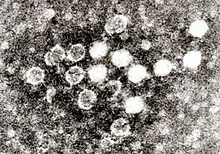Parvovirus B19
| Primate erythroparvovirus 1 | |
|---|---|
 |
|
| Electron micrograph of Parvoviruses in blood | |
| Virus classification | |
| Group: | Group II (ssDNA) |
| Order: | Unassigned |
| Family: | Parvoviridae |
| Subfamily: | Parvovirinae |
| Genus: | Erythroparvovirus |
| Species: | Primate erythroparvovirus 1 |
| Synonyms | |
|
|
Primate erythroparvovirus 1, generally referred to as B19 virus, parvovirus B19 or sometimes erythrovirus B19, was the first (and until 2005 the only) known human virus in the family Parvoviridae, genus Erythroparvovirus; it measures only 23–26 nm in diameter. The name is derived from Latin, parvum meaning small, reflecting the fact that B19 ranks among the smallest DNA viruses. B19 virus is most known for causing disease in the pediatric population; however, it can also affect adults. It is the classic cause of the childhood rash called fifth disease or erythema infectiosum, or "slapped cheek syndrome."
The virus was discovered by chance in 1975 by Australian virologist Yvonne Cossart. It gained its name because it was discovered in well B19 of a large series of microtiter plates .
Erythroviruses belong to the Parvoviridae family of small DNA viruses. It is a non-enveloped, icosahedral virus that contains a single-stranded linear DNA genome. The infectious particles may contain either positive or negative strands of DNA.The icosahedral capsid consists of two structural proteins, VP1 (83 kDa) and VP2 (58 kDa), which are identical except for 227 amino acids at the amino-terminal of the VP1-protein, the so-called VP1-unique region. Each capsid consists of a total of 60 capsomers: VP2 is the major capsid protein, and comprises approximately 95% of the total virus particle. VP1-proteins are incorporated into the capsid structure in a non-stochiometrical relation (based on antibody-binding analysis and X-ray structural analysis the VP1-unique region is assumed to be exposed at the surface of the virus particle. At each end of the DNA molecule there are palindromic sequences which form "hairpin" loops. The hairpin at the 3' end serves as a primer for the DNA polymerase. It is classified as erythrovirus because of its capability to invade red blood cell precursors in the bone marrow. Three genotypes (with subtypes) have been recognised.
...
Wikipedia
